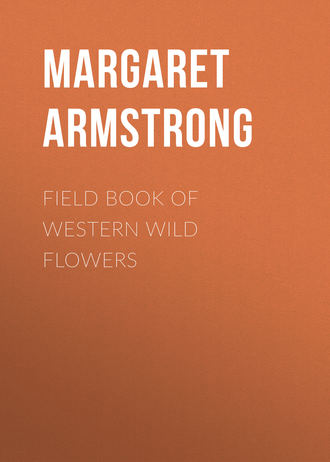 полная версия
полная версияField Book of Western Wild Flowers

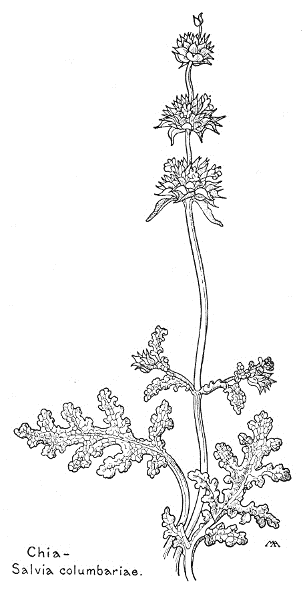
Chia – Salvia columbariae.
There are several kinds of Trichostema, all North American; herbs, sometimes shrubby; leaves toothless, or with wavy margins; flowers in clusters; calyx usually with five unequal lobes; corolla with a long slender tube and five oblong lobes nearly alike, forming in bud a roundish ball, enclosing the coiled stamens; stamens four, the upper pair longer, with very long, blue or purple filaments, conspicuously protruding from the corolla, suggesting both the Greek name, meaning "hair-like stamens," and the common name, Blue-curls.
Romero, Woolly Blue-curls
Trichostèma lanàtum
Blue
Summer, autumn
California
This is shrubby and usually has many stems, from two to four feet high, with stiffish leaves, dark green on the upper side, paler and woolly on the under, the margins rolled back, and beautiful flower-clusters, which are sometimes a foot long. The bright blue corolla is nearly an inch long, with a border shaped like a violet, the smaller buds are pink, and the purple stamens and style are two inches long and very conspicuous. The calyxes, stems, and buds are all covered with fuzzy, pink wool, forming a most unusual and beautiful color scheme, giving a changeable almost iridescent effect of mauve and pink, in remarkable contrast to the brilliant blue of the flowers. This grows on rocky hills in southern California, is pleasantly aromatic and used medicinally by Spanish-Californians. T. lanceolàtum is called Camphor Weed, because of its strong odor, like camphor but exceedingly unpleasant. It grows on dry plains and low hills in the Northwest and is an important bee-plant, blooming in summer and autumn, and is also called Vinegar Weed.
There are a few kinds of Agastache, all North American, perennial herbs, mostly tall and coarse; leaves toothed, with leaf-stalks; flowers small, in a terminal spike, with bracts; calyx bell-shaped, with five teeth and slightly two-lipped; corolla with a two-lobed, erect, upper lip, the lower lip spreading and three-lobed, the middle lobe broader and scalloped; stamens four, all with anthers, the upper pair longer; nutlets smooth. The Greek name means "many spikes."
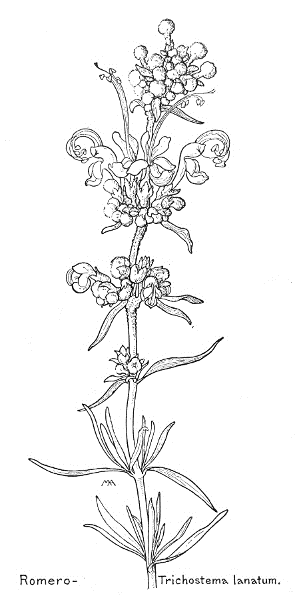
Romero – Trichostema lanatum.
Giant Hyssop
Agástache urticifòlia (Lophanthus)
Pink
Summer
West, etc.
A handsome plant, from three to five feet high, with stout, branching stems, usually smooth, sometimes hairy, and smoothish, dark green leaves. The small flowers have a green calyx, with mauve teeth, a white or pale violet corolla, and long, protruding stamens, with lilac anthers. They are crowded in spikes, from two to six inches long, and the whole effect is rather bright purplish-pink, feathery and pretty. This has a strong aromatic smell and grows along the edges of meadows and is abundant in Yosemite at moderate altitudes, but in other places reaches an altitude of over eight thousand feet and is found as far east as Colorado. A. pallidiflòra, with greenish-white calyxes and white corollas, too dull in color to be pretty, grows in the Grand Canyon and in New Mexico and Colorado.
There are several kinds of Monarda, all North American; aromatic herbs; leaves toothed; flowers crowded in heads, usually with bracts, which are sometimes colored; calyx tubular, with five teeth, often hairy inside; corolla more or less hairy outside, two-lipped, upper lip erect or arched, sometimes notched, lower lip spreading and three-lobed, the middle lobe larger; stamens two, with swinging anthers, sometimes also two rudimentary stamens; nutlets smooth. These plants are called Balm, Bergamot, and Horse-mint.
Horse-mint
Monàrda pectinàta (M. citriodora in part)
Pink
Summer
Ariz., Utah, etc.
This is handsome when growing in masses, though the flowers are not sufficiently positive in color. It grows from one to three feet high, with a stout, roughish stem, sometimes branching, and leaves which are thin and soft in texture, with a dull surface, but not rough, and more or less toothed. The flowers are nearly an inch long and project from crowded heads of conspicuous purplish bracts, tipped with bristles. The calyx is very hairy inside, the lobes tipped with long bristles, and the corolla is pale pink, lilac, or almost white, not spotted, with a very wide open, yawning mouth, the stamens and the curling tips of the pistil protruding from under the upper lip. This grows on dry plains, especially in sandy soil, as far east as Colorado and Texas, reaching an altitude of six thousand feet, and is strongly aromatic when crushed.
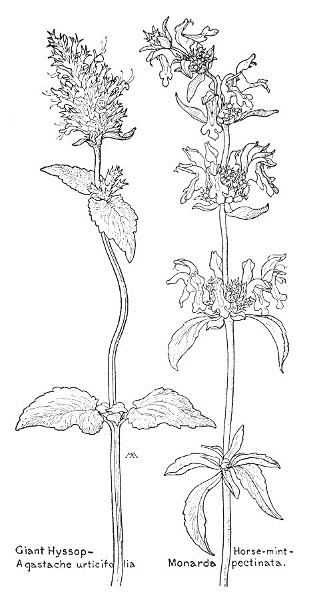
Giant Hyssop – Agastache urticifolia.
Horse-mint – Monarda pectinata.
POTATO FAMILY. Solanaceae
A large family, widely distributed, most abundant in the tropics. Ours are herbs, shrubs, or vines; leaves alternate, without stipules; flowers perfect, usually regular, in clusters; calyx and corolla usually with five united lobes; stamens on the throat of the corolla, as many as its lobes and alternate with them; ovary superior, two-celled, with a slender style; fruit a berry or capsule, with many seeds. Many important plants, such as Tobacco, Belladonna, Tomato, Egg-plant, Red-pepper, and Potato, belong to this family. Many have a strong odor.
There are several kinds of Datura, widely distributed; ours are chiefly weeds, coarse, tall, branching herbs, with rank odor and narcotic properties; leaves large, toothed or lobed, with leaf-stalks; flowers large, single, erect, with short stalks, in the forks of the stems; calyx with a long tube and five teeth, the lower part remaining in the form of a collar or rim around the base of the capsule; corolla funnel-form, with a plaited border and broad lobes with pointed tips; stamens with very long, threadlike filaments, but not protruding; style threadlike, with a two-lipped stigma; fruit a large, roundish, usually prickly capsule, giving these plants the common name, Thorn-Apple. Datura is the Hindoo name.
Tolguacha, Large-flowered Datura
Datùra meteloìdes
White
Spring, summer
Southwest, Nev., Utah
A handsome and exceedingly conspicuous plant, forming a large clump of rather coarse, dark foliage, adorned with many magnificent flowers. The stout, velvety stems are bronze-color, from two to four feet high, the leaves are dark green, velvety on the under side, and the flowers are sometimes ten inches long, white, tinged with lilac outside, drooping like wet tissue-paper in the heat of the afternoon, and with sweet though heavy scent. I remember seeing a grave in the desert, marked by a wooden cross and separated from a vast waste of sand by clumps of these great white flowers. It grows in valley lands, reaching an altitude of six thousand feet. It is used as a narcotic by the Indians and resembles D. stramònium, Jimson-weed, from Asia, common in the East and found also in the West, but it is far handsomer. D. suaveòlens, Floriponda or Angels' Trumpets, is a large shrub, with very large, pendulous, creamy flowers, and is often cultivated in the old mission gardens in California. The flowers are very fragrant at night.

Tolguacha – Datura meteloides.
There are many kinds of Physalis, most of them American, difficult to distinguish; herbs, often slightly woody below; flowers whitish or yellowish; corolla more or less bell-shaped, with a plaited border; style slender, somewhat bent, with a minutely two-cleft stigma. In fruit the calyx becomes large and inflated, papery, angled and ribbed, wholly enclosing the pulpy berry, which contains numerous, flat, kidney-shaped seeds. The name is from the Greek, meaning "bladder," and refers to the inflated calyx, and the common names, Ground-cherry and Strawberry-tomato, are suggested by the fruit, which is juicy, often red or yellow, and in some kinds is edible.
Ground-cherry
Phýsalis crassifòlia
Yellow
Southwest
A pretty, delicate, desert plant, from six to eight inches high, with branching stems and light green leaves. It is sprinkled with pretty cream-yellow flowers, which are not spotted or dark in the center, with yellow anthers, and is hung with odd little green globes, each about three-quarters of an inch long, which are the inflated calyxes containing the berries.
Bladder-cherry
Phsýalis Féndleri
Yellow
Summer
Ariz., Utah
A straggling perennial plant, about a foot high, with widely-branching, roughish stems, springing from a deep tuberous root. The leaves are dull green, roughish, rather coarse in texture, but not large, mostly less than an inch long, coarsely and irregularly toothed, and the flowers are the shape of a shallow Morning-glory, half an inch across, pale dull-yellow, marked with brown inside, with yellow anthers. This does not bear its berries close to the ground, as do many of its relations, and is not pretty. It grows in dry places, reaching an altitude of eight thousand feet.
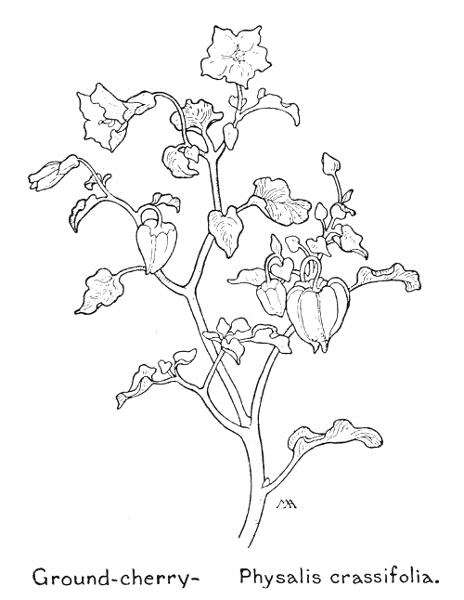
Ground-cherry – Physalis crassifolia.
There are a great many kinds of Solanum, abundant in tropical America; herbs or shrubs, sometimes climbing; often downy; calyx wheel-shaped, with five teeth or lobes, corolla wheel-shaped, the border plaited, with five angles or lobes and a very short tube; anthers sometimes grouped to form a cone, filaments short; fruit a berry, either enclosed in the calyx or with the calyx remaining on its base. This is the Latin name of the Nightshade, meaning "quieting."
Purple Nightshade
Solànum Xánti
Purple
Spring, summer
California
This is much handsomer than most of the eastern Nightshades, hairy and sticky, with several spreading stems, from one to three feet high, springing from a perennial root, with thin, roughish leaves, more or less toothed. In favorable situations the flowers are beautiful, each about an inch across, and form handsome loose clusters. The corolla is saucer-shaped, bright purple, with a ring of green spots in the center, bordered with white and surrounding the bright yellow cone formed by the anthers. The berry is pale green or purple, the size of a small cherry. This is sometimes sweet-scented and is very fine on Mt. Lowe and elsewhere in southern California, but is paler and smaller in Yosemite. Blue Witch, S. umbellíferum, is very similar, more woody below, with deep green stems, shorter branches, smaller, thicker leaves, and a dull white or purplish berry. It grows in the foothills of the Coast Ranges and Sierra Nevada Mountains and flowers chiefly in summer, but more or less all through the year.
Nightshade
Solànum Douglásii
White
Spring, summer
Southwest
A branching plant, about two feet high and across, with roughish stems and thin, smooth or slightly hairy, dark green leaves, toothless, or the margins more or less coarsely toothed. The flowers are white, tinged with lilac, with a purplish ring surrounding the yellow cone formed by the anthers. In southern California the flowers are nearly half an inch across, but smaller elsewhere. The berries are black. This is common throughout California near the coast. S. nìgrum, the common Nightshade, is a weed in almost all countries, common in waste places and in cultivated soil, and has small white flowers and black berries, about as large as peas and said to be poisonous.
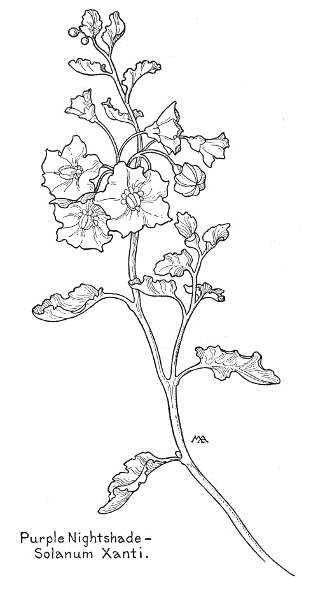
Purple Nightshade – Solanum Xanti.
There are many kinds of Nicotiana, or Tobacco, chiefly American; acrid, narcotic herbs or shrubs, usually sticky-hairy; leaves large, toothless; corolla funnel-form or salver-form, with a long tube and spreading border, plaited in the bud; stamens with threadlike filaments and broad anthers, not protruding; capsule smooth, containing numerous small seeds. The name is in honor of Nicot, diplomat and author of the first French dictionary, who sent some of these plants to Catherine de' Medici from Portugal in 1560.
San Juan Tree, Tree Tobacco
Nicotiàna glaùca
Yellow
Spring
Southwest
A very slender, loosely-branching evergreen shrub, from six to fifteen feet high, with graceful, swaying branches and smooth, thick leaves, with a "bloom," the lower leaves eight inches long. The flowers are nearly two inches long, greenish at first and then becoming a rather pretty shade of warm dull-yellow, and hang in graceful clusters from the ends of the branches. The calyx is unequally five-toothed, the tube of the corolla downy on the outside; the anthers whitish; the ovary on a yellowish disk, with a long style and two-lobed stigma, and the capsule oblong, half an inch long. This was introduced into California from South America about fifty years ago and is now common in waste places and cultivated valleys.
There are many kinds of Lycium, shrubs or woody vines, named for the country Lycia.
Desert Matrimony
Lycium Còoperi
White
Spring
Southwest
An odd-looking desert shrub, everything about it so closely crowded as to give a queer bunchy and clumsy effect. It is three or four feet high, with thick, dark gray, gnarled, woody branches, crowded with tufts of small, dull, light green leaves, which are thickish, stiffish, obscurely downy and toothless, and mingled with close little bunches of flowers. The flowers are about half an inch long, with a large, yellowish, hairy calyx, with five lobes, a white corolla, which is slightly hairy outside, with five lobes and a narrow, greenish tube, and pale yellow anthers, not protruding. They are rather pretty near by, but the appearance of the whole shrub is too pale to be effective. The familiar Matrimony Vine of old-fashioned gardens belongs to this genus.
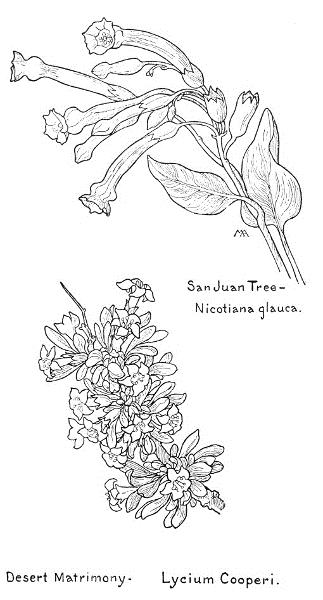
San Juan Tree – Nicotiana glauca.
Desert Matrimony – Lycium Cooperi.
FIGWORT FAMILY. Scrophulariaceae
A large family, widely distributed, most of them natives of temperate regions; chiefly herbs, with bitter juice, sometimes narcotic and poisonous; without stipules; the flowers usually irregular; the calyx usually with four or five divisions, sometimes split on the lower or upper side, or on both sides; the corolla with united petals, nearly regular or two-lipped, two of the lobes forming the upper lip, which is sometimes beaklike, and three lobes forming the lower lip; the stamens on the corolla and alternate with its lobes, two or four in number, two long and two short, and sometimes also a fifth stamen which often has no anther, the anthers two-celled; the ovary superior, usually two-celled, the style slender, the stigma sometimes forked; the fruit a pod, splitting from the top into two parts and usually containing many seeds. This is a curious and interesting family, its members very dissimilar in appearance, having expressed their individuality in many striking and even fantastic forms.
There are several kinds of Maurandia, perennial herbs, climbing by their slender twisted leaf-stalks and occasionally also by their flower-stalks; the leaves triangular-heartshaped or halberd-shaped, only the lower ones opposite; the flowers showy, purple, pink, or white; the corolla with two lines or plaits, instead of a palate, which are usually bearded.
Snap-dragon Vine
Maurándia antirrhìniflora
(Antirrhinum maurandioides)
Purple or pink and yellow
Spring
Ariz., New Mex.
This is a beautiful trailing or climbing vine, smooth all over, with charming foliage and twining stems, much like those of a Morning-glory, springing from a thickened, perennial root. The pretty flowers are over an inch long, with a purple or raspberry-pink corolla, with bright yellow blotches on the lower lip, forming an odd and striking combination of color. This blooms all through the spring and summer and may be found growing in the bottom of the Grand Canyon, near the river, where its delicate prettiness is in strange contrast to the dark and forbidding rocks over which it clambers and clothes with a mantle of tender green.
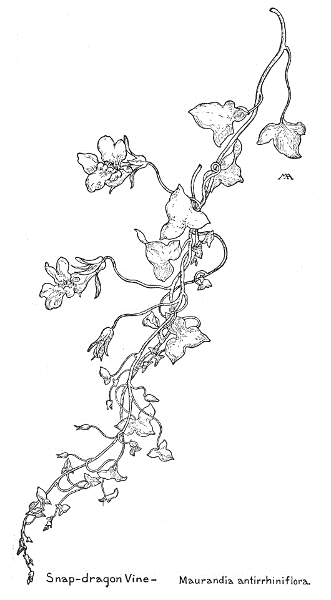
Snap-dragon Vine – Maurandia antirrhiniflora.
There are many kinds of Antirrhinum, natives of Europe, Asia, and western North America; herbs; the lower leaves often opposite, and the upper ones alternate; the sepals five; the corolla two-lipped, swollen at the base on the lower side, but with no spur, the palate nearly closing the throat; the stamens four. The name is from the Greek, meaning "nose-like," because the shape of the flowers suggests the snout of an animal.
Sticky Snap-dragon
Antirrhìnum glandulòsum
Pink, purple
Spring
California
This is a conspicuous perennial, handsome though rather coarse, hairy and sticky all over, with stout leafy stems, from two to five feet tall, with branches but no tendrils, and soft, rather dark green leaves. The flowers are half an inch long, the corolla pink with a yellow palate, and they are crowded in fine, long, one-sided clusters. This is common in the South and looks a good deal like some of the cultivated kinds; when its flowers are pinched from the sides they open their mouths in the same funny way.
White Snap-dragon
Antirrhìnum Coulteriànum
White and lilac
Spring
California
This has tendril-like pedicels, which curl around nearby plants, but the stem is stout and erect, over two feet tall, smooth below and hairy above, with smooth, dark green leaves, and bears a long, crowded, one-sided cluster of pink buds and pretty white flowers. They are each about half an inch long, with hairy calyxes, and the corollas are prettily tinged with lilac or pink, but are too pale in color, though the general effect of the plant is rather striking. The anthers are bright yellow. This grows in the South. A. vírga is a smooth plant, from two and a half to five feet tall, with many wand-like stems, springing from a perennial base, and reddish-purple flowers, about half an inch long, forming a long, rather one-sided cluster. This grows in the chaparral, on ridges of the Coast Ranges, blooming in June, but is not common.
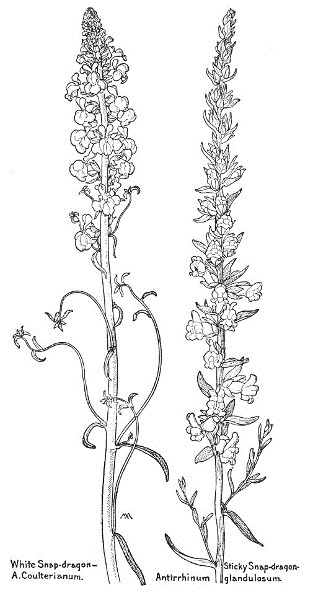
White Snap-dragon – A. Coulterianum.
Sticky Snap-dragon – Antirrhinum glandulosum.
Trailing Snap-dragon
Antirrhìnum stríctum
Blue
Spring
California
This is an odd-looking plant, from one to two feet tall, which seems unable to decide whether or not it is a vine, for the pedicels of the flowers are exceedingly slender and twist like tendrils and by their means the plant clings to its neighbors and raises its weak stems from the ground, or, if it finds no support, it stands almost erect and waves its tendrils aimlessly in the air. It is smooth all over, with dark green leaves and pretty, bright purplish-blue flowers, about half an inch long, with a pale, hairy palate, which almost closes the throat. This grows in the South, near the sea. A. vàgans is similar and is common farther north in California, growing on dry open wooded hills or in canyons of the Coast Ranges, blooming in summer and autumn.
There are many kinds of Castilleja, almost always perennials, usually parasitic on the roots of other plants, usually handsome and striking, the conspicuous feature being the large leafy bracts, colored like flowers, which adorn the upper part of the stem. They usually have several stems, springing from woody roots; leaves alternate, without leaf-stalks, green below and gradually merging above into colored bracts; flowers crowded in terminal clusters, mixed with bracts; calyx tubular, flattened, more or less cleft in front or behind, or on both sides, the lobes sometimes two-toothed, colored like the bracts, enclosing the tube of the corolla; corolla less conspicuous and duller in color than the calyx, tubular, two-lipped, the lower lip short and very small, not inflated, with three small teeth, the upper lip long and beaklike, enclosing the four stamens and single threadlike style; stigma cap-shaped or two-lobed; anther-sacs unequally attached to the filament, one by its middle and the other hanging by its tip; capsule egg-shaped or oblong, splitting open, containing many seeds. These gaudy plants are well named Indian Paint Brush, for the flower-cluster and leaf-tips look as if they had been dipped in color. Red Feather is also good but Painted Cup is rather poor, as there is nothing cup-like about the flower. They were named for Castillejo, a Spanish botanist.
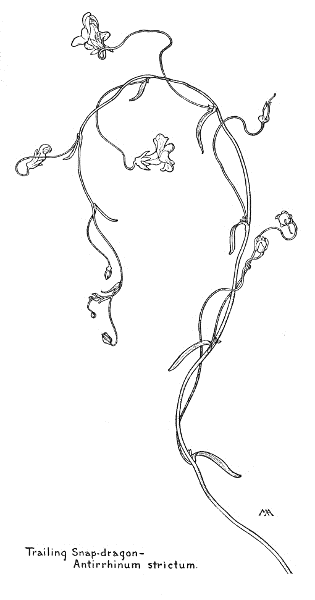
Trailing Snap-dragon – Antirrhinum strictum.
Paint Brush
Castillèja miniàta
RedSummer
Northwest
This is a very handsome kind, from two to four feet tall, with a smooth stem, and smooth leaves, which are not crinkled, toothed, or lobed, and with more or less hairy bracts, which are beautifully tinted with many shades of pink, red, and purple. This is a magnificent plant, especially when we find it growing along irrigation ditches, among blue Lupines, yellow Mimulus and other bright flowers, where the combinations of color are quite wonderful, and it is the handsomest and commonest sort around Yosemite, where it grows in meadows and moist places, from the foothills nearly up to timber-line.
Scarlet Paint Brush
Castillèja pinetòrum
Red and yellow
Summer
Cal., Oreg.
This is not quite so large or handsome as the last, but gives much the effect of a brush dipped in red paint, for the yellowish bracts are beautifully tipped with scarlet and the flowers are also bright red. The rough stem is a foot or more tall, the roughish dark green leaves are not toothed or lobed, but have crinkled edges, and the bracts usually have three lobes. These plants grow in the mountains and often make bright patches of color in the landscape.
Paint Brush
Castillèja angustifòlia
RedSpring, summer
Utah., Nev.
This is very variable, and is usually about a foot high, with several hairy stems, springing from a long yellow root. The leaves are slightly rough, but not coarse, with fine white hairs along the margins, and light gray-green in color, the lowest ones not lobed, a few of the upper ones with two lobes, but most of the leaves, and the bracts, slashed into three lobes. The calyx is covered with white hairs, and the upper lip of the corolla is bright green. The whole plant is most beautiful and harmonious in color, not coarse like many Castillejas, and the upper part is clothed with innumerable delicate yet vivid tints of salmon, rose, and deep pink, shading to scarlet and crimson, forming a charming contrast to the quiet tones of the lower foliage. This grows in gravelly soil, on dry plains and hillsides, and the clumps of bloom are very striking among the sage-brush.

